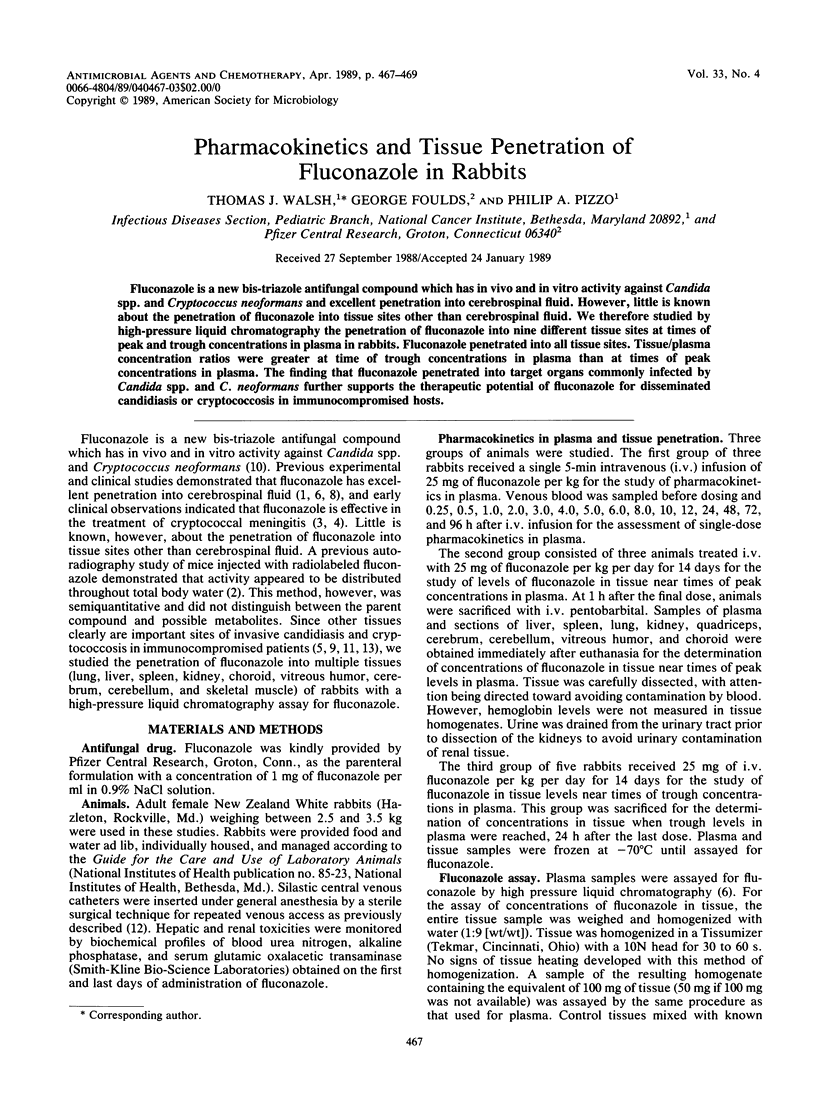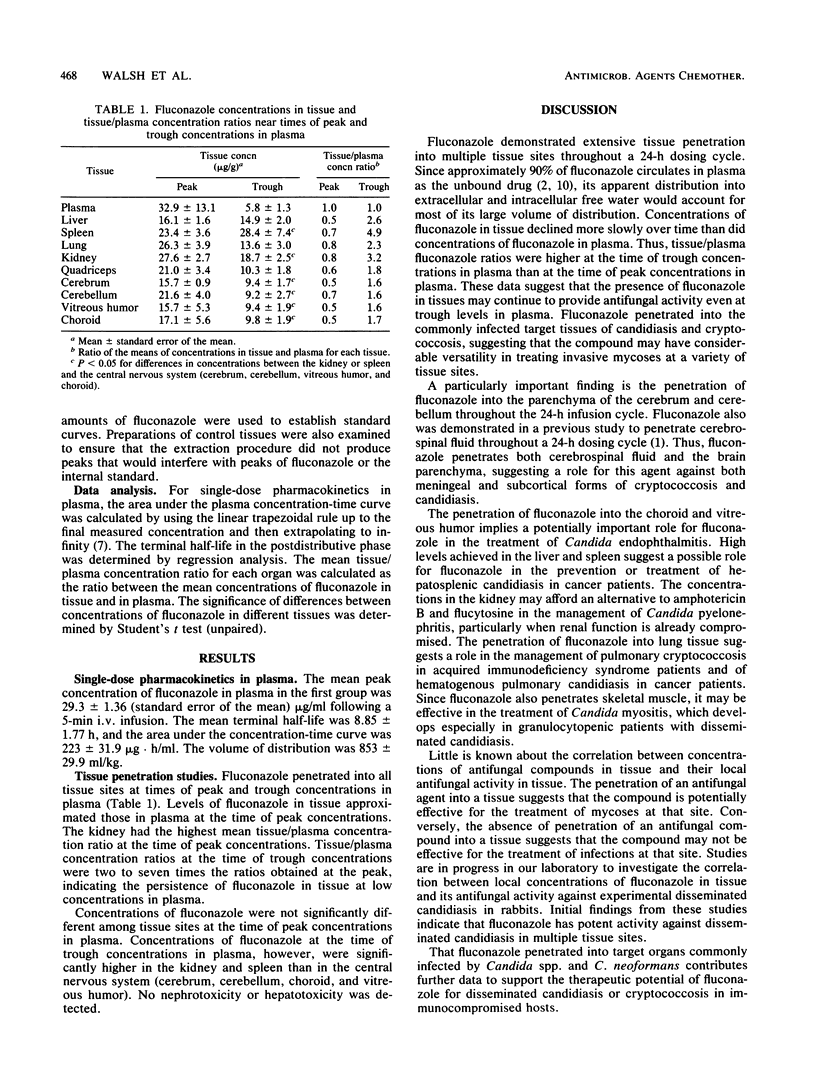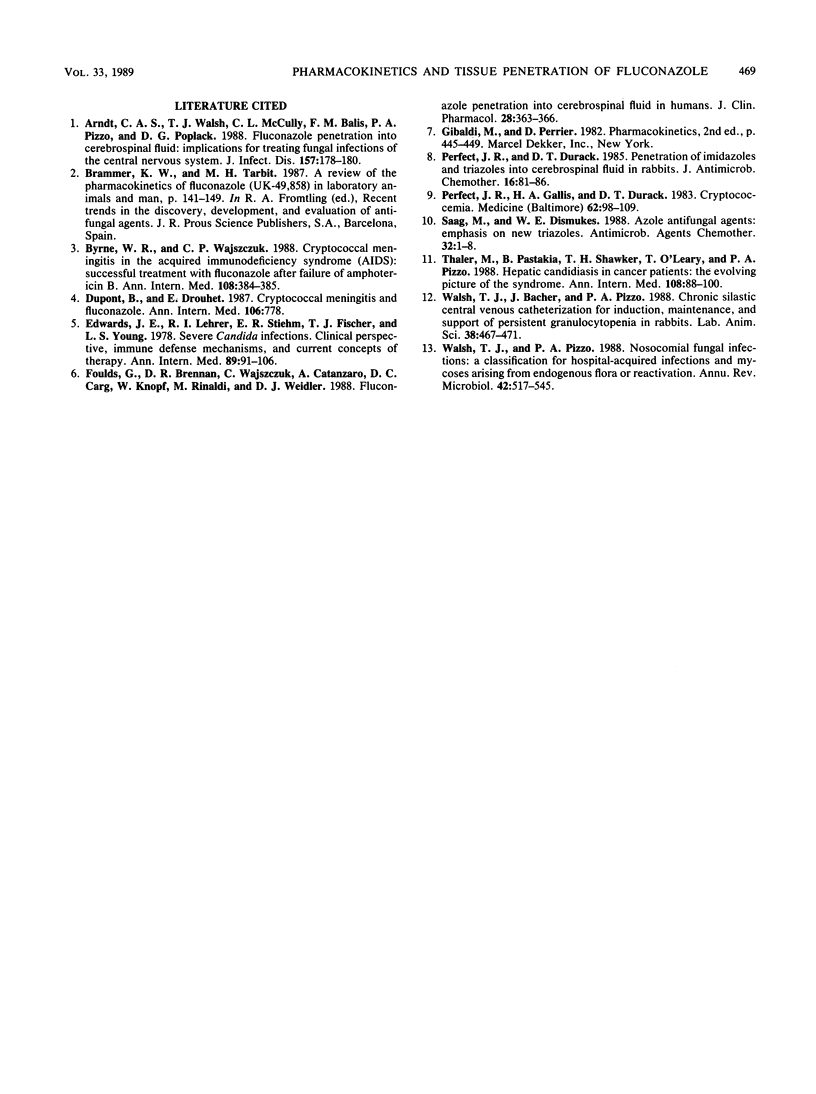Abstract
Fluconazole is a new bis-triazole antifungal compound which has in vivo and in vitro activity against Candida spp. and Cryptococcus neoformans and excellent penetration into cerebrospinal fluid. However, little is known about the penetration of fluconazole into tissue sites other than cerebrospinal fluid. We therefore studied by high-pressure liquid chromatography the penetration of fluconazole into nine different tissue sites at times of peak and trough concentrations in plasma in rabbits. Fluconazole penetrated into all tissue sites. Tissue/plasma concentration ratios were greater at time of trough concentrations in plasma than at times of peak concentrations in plasma. The finding that fluconazole penetrated into target organs commonly infected by Candida spp. and C. neoformans further supports the therapeutic potential of fluconazole for disseminated candidiasis or cryptococcosis in immunocompromised hosts.
Full text
PDF


Selected References
These references are in PubMed. This may not be the complete list of references from this article.
- Arndt C. A., Walsh T. J., McCully C. L., Balis F. M., Pizzo P. A., Poplack D. G. Fluconazole penetration into cerebrospinal fluid: implications for treating fungal infections of the central nervous system. J Infect Dis. 1988 Jan;157(1):178–180. doi: 10.1093/infdis/157.1.178. [DOI] [PubMed] [Google Scholar]
- Byrne W. R., Wajszczuk C. P. Cryptococcal meningitis in the acquired immunodeficiency syndrome (AIDS): successful treatment with fluconazole after failure of amphotericin B. Ann Intern Med. 1988 Mar;108(3):384–385. doi: 10.7326/0003-4819-108-3-384. [DOI] [PubMed] [Google Scholar]
- Dupont B., Drouhet E. Cryptococcal meningitis and fluconazole. Ann Intern Med. 1987 May;106(5):778–778. doi: 10.7326/0003-4819-106-5-778_2. [DOI] [PubMed] [Google Scholar]
- Edwards J. E., Jr, Lehrer R. I., Stiehm E. R., Fischer T. J., Young L. S. Severe candidal infections: clinical perspective, immune defense mechanisms, and current concepts of therapy. Ann Intern Med. 1978 Jul;89(1):91–106. doi: 10.7326/0003-4819-89-1-91. [DOI] [PubMed] [Google Scholar]
- Foulds G., Brennan D. R., Wajszczuk C., Catanzaro A., Garg D. C., Knopf W., Rinaldi M., Weidler D. J. Fluconazole penetration into cerebrospinal fluid in humans. J Clin Pharmacol. 1988 Apr;28(4):363–366. doi: 10.1002/j.1552-4604.1988.tb03159.x. [DOI] [PubMed] [Google Scholar]
- Perfect J. R., Durack D. T., Gallis H. A. Cryptococcemia. Medicine (Baltimore) 1983 Mar;62(2):98–109. doi: 10.1097/00005792-198303000-00003. [DOI] [PubMed] [Google Scholar]
- Perfect J. R., Durack D. T. Penetration of imidazoles and triazoles into cerebrospinal fluid of rabbits. J Antimicrob Chemother. 1985 Jul;16(1):81–86. doi: 10.1093/jac/16.1.81. [DOI] [PubMed] [Google Scholar]
- Saag M. S., Dismukes W. E. Azole antifungal agents: emphasis on new triazoles. Antimicrob Agents Chemother. 1988 Jan;32(1):1–8. doi: 10.1128/aac.32.1.1. [DOI] [PMC free article] [PubMed] [Google Scholar]
- Thaler M., Pastakia B., Shawker T. H., O'Leary T., Pizzo P. A. Hepatic candidiasis in cancer patients: the evolving picture of the syndrome. Ann Intern Med. 1988 Jan;108(1):88–100. doi: 10.7326/0003-4819-108-1-88. [DOI] [PubMed] [Google Scholar]
- Walsh T. J., Bacher J., Pizzo P. A. Chronic silastic central venous catheterization for induction, maintenance and support of persistent granulocytopenia in rabbits. Lab Anim Sci. 1988 Aug;38(4):467–471. [PubMed] [Google Scholar]
- Walsh T. J., Pizzo P. A. Nosocomial fungal infections: a classification for hospital-acquired fungal infections and mycoses arising from endogenous flora or reactivation. Annu Rev Microbiol. 1988;42:517–545. doi: 10.1146/annurev.mi.42.100188.002505. [DOI] [PubMed] [Google Scholar]


